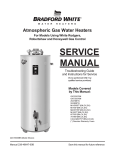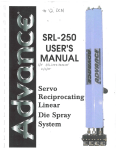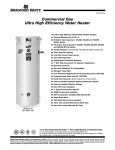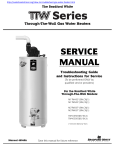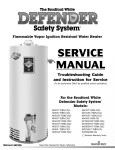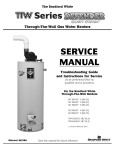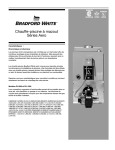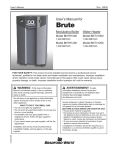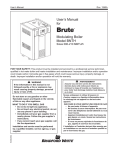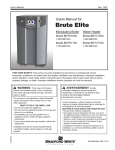Download Bradford-White Corp 07.05.228.00 Water Heater User Manual
Transcript
Atmospheric Gas Water Heaters SERVICE MANUAL Troubleshooting Guide and Instructions for Service (To be performed ONLY by qualified service providers) Models Covered by This Manual : GX225S*BN GX155S*BN 25X78B*N 55X80B*N M1XR65T*(BN,CX) MI75S*(BN,CX) M2XR75S*(BN,CX) MI100T*(BN,CX) 65T65*(BN,CX) 75T80*(BN,CX) (*) Denotes Warranty Year Manual 238-46647-00A Save this manual for future reference Table of Contents Page Service Procedure Trouble shooting Chart 3 --- Thermocouple Testing and Replacement 4 AG-I Pilot Assembly Inspection Cleaning and Replacement 5 AG-II Combination Thermostat/Gas Valve Testing and Replacement 6 AG-III Burner Operation Inspection, Adjustment, Cleaning and Replacement 10 AG-IV Dip Tube and Anode Inspection and Replacement 13 AG-V Page 2 2 Troubleshooting Chart SYMPTOM Pilot will not light Pilot will not stay lit when button is released Pilot will light, but the main burner will not come on Pilot goes out periodically (after heating cycles, once a day, once a week etc.) Not enough hot water PROBABLE CAUSE CORRECTIVE ACTION 1. No incoming gas or too low gas pressure. 2. Gas control knob set to wrong position. 3. Pilot light button not being fully depressed when attempting to light pilot. 4. Pilot orifice or pilot tube is obstructed or kinked. 1. Turn on gas supply and/or check line pressure. 2. Review lighting instruction. Set combination/thermostat gas valve to correct position. 3. Review lighting instruction. Fully depress pilot lighting button. 4. Clean, repair or replace. 1. Poor thermocouple connection at combination thermostat/gas valve. 2. Thermocouple not fully engaged in pilot assembly bracket. 3. Pilot flame is not fully enveloping the thermocouple “hot” junction. 4. Weak or defective thermocouple. 5. Open ECO on combination thermostat/ gas valve. 6. Defective magnet in combination thermostat/gas valve. 1. Check connection at combination thermostat/gas valve. Proper tightness should be finger tight plus ¼ turn. 2. Inspect thermocouple to ensure that it is fully engaged into pilot bracket. 3. Adjust tip of thermocouple to be fully engulfed by pilot flame. 4. Check thermocouple and replace if necessary. 5. Check ECO continuity and replace combination thermostat/gas valve if necessary. 6. Check magnet operation and replace combination thermostat/gas valve if necessary. 1. Combination thermostat/gas valve set too low for desired water temperature. 2. Combination thermostat/gas valve temperature is satisfied. 3. Insufficient gas supply or low gas pressure. 4. Combination thermostat/gas valve has wide differential or is out of calibration. 1. Adjust temperature dial on combination thermostat/gas valve. 2. Check temperature dial setting on combination thermostat/gas valve. 3. Check gas supply and line pressure. 4. Check combination thermostat/gas valve for proper operation, replace if necessary. 1. Insufficient combustion air supply. 2. Incorrect, clogged vent system/ vent terminal or location. 3. Inconsistent gas supply or gas pressure. 1. Combination thermostat/gas valve set too low for desired water temperature. 2. Cold inlet water temperature is very cold. 3. High demand periods. 4. Incorrectly sized water heater for application. 5. Combination thermostat/gas valve is out of calibration/not functioning. 6. Out of spec dip tube is diluting hot water with cold water. 7. Integrated mixing device is set too low for desired water temperature. 1. Verify adequate combustion air is available to the unit. Check and clear Jacket slot openings of any dirt, dust, restrictions or other obstructions. 2. Check venting for proper sizing and proper operation 3. Check gas supply and line pressure. 1. Check dial on combination thermostat/gas valve. 2.Extremely cold water going into the heater will decrease the amount of hot water produced. It may be necessary to temper incoming water supply. 3. Adjust high demand usage. 4. Contact Plumbing professional. 5. Check combination thermostat/gas valve for proper operation, replace if necessary. 6. Inspect dip tube and replace if necessary. 7. Reset device using the procedure in the instructions included with the device. Page 3 3 SERVICE PROCEDURE 1. See Service Procedure AG-III, Page 6. 4. See Service Procedure AG-II, Page 5. 4. See Service Procedure AG-I, Page 4 5. See Service Procedure AG-III, Page 6 6. See Service Procedure AG-III, Page 6 2. See Installation & operation manual. 3. See Service Procedure AG-III, Page 6 4. See Service Procedure AG-III, Page 6 3. See Service Procedure AG-III, Page 6 5. See Service Procedure AG-III, Page 6 6. See Service Procedure AG-V, Page 13 SERVICE PROCEDURE AG-I Thermocouple Testing and Replacement OPEN CIRCUIT THERMOCOUPLE TESTING Step 1. Disconnect thermocouple from combination thermostat/gas valve. Step 2. Using a multimeter capable of measuring millivolts, connect one alligator clip to the end ball or contact portion of the thermocouple, and the other alligator clip to copper portion of the thermocouple. Step 3. Following the lighting instruction label on the heater, proceed to light the pilot and allow to operate for three minutes. It will be necessary to hold the pilot button down continuously throughout this test. A reading of 20 to 30 millivolts indicates good thermocouple output. THERMOCOUPLE REPLACEMENT Step 1. Turn off gas supply to water heater. Rotate knob of combination thermostat/gas valve to “OFF” position. For Robertshaw Control, rotate knob clockwise to the “OFF” position. For White Rodgers Control, depress knob slightly and rotate clockwise to the “OFF” position. Step 2. Remove outer jacket door. Step 3. Slide open inner combustion chamber door. Step 4 Disconnect thermocouple from combination thermostat/gas valve (3/8" wrench). Locate other end of thermocouple inside of combustion chamber and remove from pilot bracket. Pull firmly pulling away from the pilot assembly. Step 5. Install new thermocouple into pilot bracket making certain the thermocouple is fully engaged into the pilot bracket. Connect other end of thermocouple to combination thermostat/gas valve (finger tight + ¼ turn). Step 6. Route carefully through the relief opening in the combustion chamber skirt. Step 7. To resume operation follow the instructions located on the lighting instruction label or the lighting instructions located in the installation and operation manual. Step 8. Slide inner door closed when finished. Thermocouple position Page 4 4 SERVICE PROCEDURE AG-II Pilot Assembly Inspection, Cleaning and Replacement R PILOT ASSEMBLY INSPECTION, CLEANING AND REPLACEMENT For White Rodgers Control, depress knob slightly and rotate clockwise to the “OFF” position. Step 1. Turn off gas supply to water heater. Rotate knob of combination thermostat/gas valve to “OFF” position. Step 2. Remove outer jacket door. Step 3. Slide open inner combustion chamber door. Step 4 Disconnect thermocouple (3/8" wrench), pilot tube (7/16" wrench), and feedline (¾" wench) from combination thermostat/gas valve. For Robertshaw Control, rotate knob clockwise to the “OFF” position. NOTE: Feedline nut for natural gas control uses right hand threads, LP control uses left hand thread. Step 5 Remove burner assembly from combustion chamber. Step 6. Remove pilot assembly from feedline (¼" drive tool) Step 7. Inspect pilot for the following: Feedline Nut a) Primary air openings for blockage. Must be free from any debris (dirt, lint, etc). b) Kinks or cracks in the pilot tube. If found, the pilot must be replaced. Step 8. Inspect pilot orifice: Primary Air Opening a) Remove ½" nut from bottom of pilot assembly. b) Remove pilot tube and pilot orifice. c) inspect pilot orifice for blockage, must be cleaned or replaced. Pilot Orifice Step 9. Install pilot assembly to feedline, secure with screw from step 7. Step 10. Re-Install burner assembly into combustion chamber, connect feedline, pilot tube and thermocouple to combination thermostat/gas valve. Step 11. Slide inner combustion chamber door closed and re-attach outer jacket door. Step 12. To resume operation follow the instructions located on the lighting instruction label or the lighting instructions located in the installation and operation manual. Page 5 5 SERVICE PROCEDURE AG-III Combination Thermostat/Gas Valve Testing and Replacement Combination Thermostat/Gas Valve Testing and Replacement The combination thermostat/gas valve is a non repairable device. If trouble shooting has determined a problem with the combination thermostat/gas valve, it must be replaced. If the burner and/or pilot do not function, service checks for gas pressure, thermocouple output, magnet assembly and ECO are to be performed. If these check OK, the combination thermostat/gas valve may be faulty. LINE PRESSURE The combination thermostat/gas valve is designed for a maximum line pressure of 14.0" w.c. and a minimum line pressure of 1.0"w.c. over the water heater rated manifold pressure. Line pressure must be checked with burner on and burner off to assure proper readings. MANIFOLD PRESSURE TESTING (this procedure assumes a maximum line pressure of 14.0" w.c.) Step 1. Set combination thermostat/gas valve to “OFF” position. Step 2. Remove pressure tap plug (3/16" Allen wrench) and install pressure tap (7/16" wrench) Step 3. Connect manometer to pressure tap. Step 4 Follow lighting instructions and proceed to light main burner and observe manometer reading. Step 5 Proper operating range for natural gas is 4.0 ±0.3" W.C. Proper operating range for L.P. gas is 10.0 ±0.5" W.C. Step 6 If pressure is OK, set combination thermostat/gas valve to “OFF” remove manometer and pressure tap and replace pressure tap plug. Check for gas leaks before placing water heater back in operation. If pressure is out of the specification noted in step 5, proceed to step 7 or 8 for proper service procedure. Step 7 For White Rodgers control, the manifold pressure is not adjustable. If manifold pressure is outside the range in step 5, the control must be replaced. Step 8 For Robertshaw control, the manifold pressure is adjustable, proceed to step 9 for adjustment procedure Step 9 While burner is in operation, remove regulator access cap to expose the regulator adjusting screw. With small screw driver, rotate adjusting screw clockwise to increase pressure and counter clockwise to decrease pressure. Step 10 Replace regulator access cap, set combination thermostat/gas valve to “OFF”. Remove manometer and pressure tap and replace pressure tap plug. Check for gas leaks before placing water heater back in operation. Page 6 6 Pressure Tap Shown Installed SERVICE PROCEDURE AG-III Combination Thermostat/Gas Valve Testing and Replacement THERMOCOUPLE TESTING See SERVICE PROCEDURE AG-I MAGNET ASSEMBLY TESTING (White Rodgers Control) Step 1. Following the lighting instruction label on the heater, proceed to light the pilot and allow to operate for three minutes. If the pilot will not stay lit, hold the pilot button (located on the combination thermostat/gas valve) down during this test Step 2. Using a multimeter capable of measuring millivolts, connect one lead using an alligator clip to the copper sheath of the thermocouple, use the second lead of the multi meter to probe the top terminal located at the back of the combination thermostat/gas valve. Probe top terminal on back of combination thermostat/gas valve Alligator clip to copper sheath of thermocouple Step 6. With a meter reading of 13 millivolts or greater, rotate knob of combination thermostat/gas valve to the “OFF” position. Step 7. The magnet should remain closed for a drop of at least 6 millivolts. You will here a “snap” or “click” sound when the magnet opens, if you hear this sound prior to a drop of 6 millivolts, the magnet is out of specification and the combination thermostat/gas valve should be replaced. MAGNET ASSEMBLY TESTING (Robertshaw Control) Step 1. Disconnect thermocouple from combination thermostat/gas valve. Step 2. Connect a thermocouple adaptor (Robertshaw P/N 75036) at the thermocouple location in the combination thermostat/gas valve. Step 3. Reconnect thermocouple to adaptor. Make certain all connections are tight (finger tight plus ¼” turn). Step 4 Using a multimeter capable of measuring millivolts, connect one alligator clip to the set screw of the adaptor and the other alligator clip to copper portion of the thermocouple. Step 5. Following the lighting instruction label on the heater, proceed to light the pilot and allow to operate for three minuets. Step 6. With a meter reading of 13 millivolts or greater, rotate knob of combination thermostat/gas valve to the “OFF” position. Step 7. The magnet should remain closed for a drop of at least 6 millivolts. You will here a “snap” or “click” sound when the magnet opens, if you hear this sound prior to a drop of 6 millivolts, the magnet is out of specification and the combination thermostat/gas valve should be replaced. Page 7 7 SERVICE PROCEDURE AG-III Combination Thermostat/Gas Valve Testing and Replacement ECO (Energy Cut Off) TESTING Step 1. Disconnect thermocouple from combination thermostat/gas valve. Step 2. Using a multimeter capable of measuring Ohms (or continuity), attach one lead (alligator clip) to the pilot tube. Insert the other lead (probe) fully into the magnet opening, Be sure the probe makes contact only at the top center of the magnet opening. Do not allow the probe to make contact with the threaded sides of the opening. Step 3. If continuity is indicated, the ECO is OK. If continuity is not indicated, the ECO has opened and the combination thermostat/gas valve must be replaced. COMBINATION THERMOSTAT/GAS VALVE REPLACEMENT Step 1. Rotate knob of the combination thermostat/gas valve to the “OFF” position. Step 2. Turn off gas supply to water heater. Step 3. Disconnect gas supply line from combination thermostat/gas valve. Step 4. Turn off water supply and drain water heater completely. Step 5. Remove outer jacket burner access door. Step 6. Slide open inner combustion chamber door. Page 8 8 For White Rodgers Control, depress knob slightly and rotate clockwise to the “OFF” position. For Robertshaw Control, rotate knob clockwise to the “OFF” position. SERVICE PROCEDURE AG-III Combination Thermostat/Gas Valve Testing and Replacement Step 7. Removal of combination thermostat/gas valve. a) Disconnect main burner feedline (¾” wrench), pilot tube (7/16" wrench) and thermocouple (3/8" wrench) from combination thermostat/gas valve & remove burner from combustion chamber. NOTE: Feed line nut for natural gas control uses right hand threads, LP control uses left hand thread. b) Remove Combination Thermostat/Gas Valve from heater, rotating counter clockwise using a control body wrench or a length of ½" NPT pipe threaded into inlet of control. Wrench Boss To remove or install control, insert only ½" NPT threaded pipe into inlet and use to loosen or tighten control. Step 8. Installation of Combination Thermostat/Gas Valve. a) Install new combination thermostat/gas valve using a control body wrench or a length of ½" NPT pipe threaded into inlet of control. DO NOT OVER TIGHTEN. Use caution not to damage cast aluminum body of combination thermostat/gas valve. Be certain not to damage the bundled wire leads. NOTE: Combination thermostat/gas Valve must be installed in proper upright position to assure the feedline will align properly at the inner door flange. DO NOT OVER TIGHTEN. If control is turned past proper alignment, do not reverse direction to align. b) Reattach main burner feedline, pilot tube and thermocouple to combination thermostat/gas valve. NOTE: Feedline nut for natural gas control uses right hand threads, LP control uses left hand thread. c) Connect gas supply piping to inlet of control. Use back up wrench on wrench boss of control, never use back up wrench on body of control. Step 9. Reconnect gas supply to Combination Thermostat/Gas Valve. Step 10. Resume water supply to water heater. Be sure tank is full of water. Step 11. Slide inner combustion chamber door closed Step 12. Re-attach outer jacket door. Step 13. To resume operation follow the instructions located on the lighting instruction label or the lighting instructions located in the installation and operation manual. Page 9 9 SERVICE PROCEDURE AG-IV Burner Operation Inspection, Adjustment Cleaning and Replacement R MAIN BURNER: Inspection, Adjustment, Cleaning and Replacement At periodic intervals (not more then 6 months) a visual inspection should be made of the main burner for proper operation and to insure no debris accumulating. Main burner should light smoothly from pilot and burn with a blue flame with a minimum of yellow tips. Steel burner models have a self adjusting air mixture and do not have an adjustable air shutter. Cast iron burner can have the gas and air mixture properly proportioned by adjusting the air shutter on the mixer face of the main burner (see step 2 below). Main burner must be free from any debris accumulation that may effect burner operation (see burner cleaning procedure in this manual). CAST IRON BURNER ADJUSTMENT WARNING Inner door and burner components may be HOT when performing this operation. Take necessary precaution to prevent personal injury. Step 1. With main burner in operation slide the inner combustion chamber door open. Step 2. To adjust for proper burning, loosen the air shutter nut, rotate the shutter to close the opening in the burner, then slowly rotate the shutter until the yellow tips are minimized. Tighten the air shutter nut. Too much air will cause the flame to lift off the burner ports and create noisy burner operation. Too little air may result in soot formation. Air Shutter Nut Page 10 10 SERVICE PROCEDURE AG-IV Burner Operation Inspection, Adjustment Cleaning and Replacement MAIN BURNER: Inspection, Adjustment, Cleaning and Replacement (cont.) Step 3. Fully inspect combustion chamber for debris or carbon build up. Step 4. Burner should operate as adjusted in step 2, if not, repeat procedure compensating air shutter position for proper burner operation with inner door closed. Step 5. It may be necessary to clean main burner or main burner orifice to achieve proper burner operation. If cleaning is required proceed to burner cleaning section in this procedure. BURNER CLEANING (Steel & Cast Iron) Step 1. Slide open inner combustion chamber door. Step 2. Disconnect main burner feed line (¾” wrench), pilot tube (7/16" wrench) and thermocouple (3/8") wrench from combination thermostat gas valve and remove burner assembly from combustion chamber. NOTE: Feedline nut for natural gas control uses right hand threads, LP control uses left hand thread. Step 3. Thoroughly inspect burner surface area and burner ports and remove any loose debris accumulation. Burner Surface Area Burner Port Area Step 4. Burner Venturi Opening On cast iron burners, inspect for any debris build up inside burner venturi. If found, disconnect feedline from burner and remove debris build up. Feedline Page 11 11 SERVICE PROCEDURE AG-IV Burner Operation Inspection, Adjustment Cleaning and Replacement BURNER CLEANING (Cont.) Step 5. Disconnect (unscrew) Main burner (stamped steel burner) from main burner orifice or on cast iron burners, loosen air shutter & disconnect (unscrew) feedline from burner. Step 6. Remove main burner orifice from feed line (½” wrench on steel burner, 3/8" wrench on cast iron). Inspect and clean if necessary. Step 7. Inspect pilot assembly per service procedure AG-II. Step 8. Reassemble burner. Step 9. Inspect combustion chamber area of heater and clean if needed prior to reinstallation of burner assembly. Step 10. Reinstall burner assembly into combustion chamber, reconnect feedline, thermocouple and pilot tube to the combination thermostat/gas valve. Step 11. Slide inner combustion chamber door closed and reattach outer jacket door. Step 12. To resume operation, follow the instructions located on the lighting instruction label or the lighting instructions located in the installation and operation manual. Page 12 12 SERVICE PROCEDURE AG-V Dip Tube and Anode Inspection and Replacement R DIP TUBE INSPECTION AND REPLACEMENT WARNING Heater components and stored water may be HOT when performing the following steps in this procedure. Take necessary precaution to prevent personal injury. Step 1. Rotate knob of combination thermostat/gas valve to “OFF” position. For White Rodgers Control, depress knob slightly and rotate clockwise to the “OFF” position. For Robertshaw Control, rotate knob clockwise to the “OFF” position. Step 2. Turn off cold water supply to heater. Connect hose to drain spigot of water heater and route to an open drain. Open a nearby hot water faucet to vent heater for draining. Open drain spigot on water heater and allow heater to drain to a point below the inlet connection nipple. Step 3. Disconnect inlet nipple from plumbing system. Step 4 With an appropriate wrench, remove inlet nipple/dip tube from the water heater. Use caution not to damage nipple threads. Step 5. Visually Inspect inlet nipple/dip tube. Inlet nipple/dip tube should be free of cracks and any blockage. Hydro-jets (small curved openings) should be open and free of any blockage. Anti-siphon hole located approximately 6" from the bottom of nipple, should be free of any blockage. Any damage such as cracks, restriction due to deformation or unintentional holes are not field repairable and the inlet nipple/dip tube must be replaced. Step 6. Upon completion of inspection or subsequent replacement, reinstall inlet nipple/dip tube into heater. Connect nipple to plumbing system, resume water supply and refill heater with water. Step 7. To resume operation follow the instructions located on the lighting instruction label or the lighting instructions located in the installation and operation manual. Page 13 13 SERVICE PROCEDURE AG-V Dip Tube and Anode Inspection and Replacement ANODE INSPECTION AND REPLACEMENT WARNING Heater components and stored water may be HOT when performing the following steps in this procedure. Take necessary precaution to prevent personal injury. Step 1. Turn off water supply to water heater. Rotate knob of combination thermostat/gas valve to “OFF” position. For White Rodgers Control, depress knob slightly and rotate clockwise to the “OFF” position. For Robertshaw Control, rotate knob clockwise to the “OFF” position. Step 2. Turn off cold water supply to heater. Connect hose to drain spigot of water heater and route to an open drain. Open a nearby hot water faucet to vent heater for draining. Open drain spigot on water heater and allow heater to drain to a point below the outlet connection nipple. Step 3. Disconnect outlet nipple from plumbing system. Step 4 With an appropriate wrench, remove outlet nipple/anode from the water heater. Use caution not to damage nipple threads. Step 5. Visually Inspect outlet nipple/anode. Outlet nipple/anode should show signs of depletion, this is normal. If depletion is ½ of the original anode diameter (approximately ¾” diameter), replacement is recommended. If any of the steel core of the anode is exposed, replacement is recommended. Step 6. Upon completion of inspection or subsequent replacement, reinstall outlet nipple/anode into heater. Connect nipple to plumbing system, resume water supply and refill heater with water. Step 7. To resume operation, follow the instructions located on the lighting instruction label or the lighting instructions located in the installation and operation manual. Page 14 14 NOTES 15 Application & Sizing/800-523-2931 Fax/215-641-1612 Email [email protected] [email protected] www.bradfordwhite.com www.bradfordwhitecanada.com
















